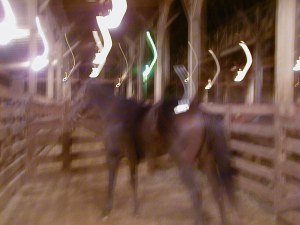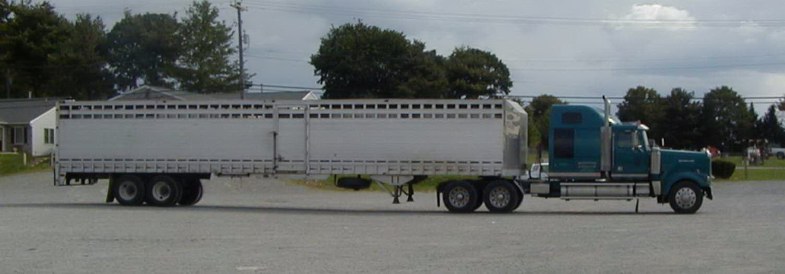
AUCTIONS
24 Hours Is All It Takes
24 Hours Is All It Takes
24 hours is all it takes... a horse owner brings in his horse to an auction, well groomed and show sheened, thinking the horse will get a great home and he'll make a quick sale. Within minutes, maybe hours, the gavel bangs and the word SOLD is shouted through the audience. The owner gives the horse a quick pat, waits a moment in case who ever bought the horse has a question, and then goes to the office to settle up whether he sees the purchaser or not.
Little does the old owner know, that chances are, his horse will be roughly thrown in a pen with other loose horses where he can be seriously injured, and then later crammed onto a trailer and hauled off into the unknown. Within 24 hours, that horse has been loved, cared for, trailered, confused, sold, and confused some more. Then to be stressed out during a long haul, maybe even trampled, while fighting to keep his feet under him while standing on filthy metal flooring... only to be off loaded at a strange cold building filled with callous people, that does not have a clean box stall with fresh shavings and cool clean water waiting for him.
All that waits for him is a bare metal box...... .and a steel bolt.
On Monday, October 9, 2000, Nickerson Livestock was in attendance at the horse auction being held at the New Holland Sales Stables, Inc.
Several debilitated, sick sore and lames horses were shipped to New Holland from Eyler's Stables in Thurmont, MD, where they stood waiting to take their final ride. These horses were marked for death, with small rectangular yellow tags that prohibit the general public from effectuating a purchase. A foundation bred quarter horse with one clouded over eye paced the pen with worry. A splashy overo paint rump looked promising past the sea of mostly bay thoroughbreds, until you walked around the pen to see that his front legs were mishapen and he stood much like a bull dog, with his knees forming an outward "v" on both sides (picture posted on Photo Page). Thoroughbreds were also in this pen, and heels were flying and squeals were reverberating.
While these horses waited by the loading docks, Nickerson, along with many other dealers, stood across from the auctioneer and silently sealed the fates of numerous horses, with either a nod or a tip of a finger. One horse, a blind thoroughbred, had the great misfortune of being bid upon by Nickerson. Later that night, he was loaded onto a large single tier trailer, enroute to Viande Richelieu, Inc., which is also known as Richelieu Meat, Inc. - a slaughterhouse in Massueville, Quebec, Canada.
On Tuesday, October 10, 2000, a person from NY learned of the sale of this blind horse and decided she wanted to intervene and save this horse's life. She started by contacting the auction. The woman who she dealt with was quite callous, stating the horse was bought by Nickerson of NY, loaded up the night before and enroute to Canada, " which is where he was meant to go". This compassionate New Yorker was not letting this horse go that easy. She reached the Canadian slaughterhouse, Richelieu Meat, and was advised that Nickerson had dropped off his load early that morning. The representative from the slaughterhouse advised the woman that he would have to check to see if the horse was still alive, and that she should call back in 15 minutes. Needless to say, the woman did call back, only to be told that the horse was dead. She inquired as to when the horse was slaughtered, and based upon the slaughterhouse workers response, the horses was slaughtered for human consumption some time between 1:00 and 1:15 p.m. The slaughterhouse worker then took the conversation a step further to say that his "boss" told him this was a federal facility, and that once a horse arrived, it was not allowed to leave alive.
Was the horse really dead? Why did the representative have to discuss the matter with his boss? Nickerson Livestock must do business with Richelieu on a regular basis in order for representatives to know him and his schedule and warrant consultation with a supervisor on the inquiry. I just wonder if Richelieu is aware of the fact that approximately 50% of the horses sold at the Monday sale did not have a health certificate or a negative coggins, and that there is a good possibility that horses purchased and delivered to them were not fit for human consumption. I wonder if Richelieu Meat realizes the number of violations made by dealers to deliver these horses to them. I wonder if Richelieu Meat ever stopped to think of all the pharmaceuticals used on the horses they slaughter for human consumption (Tainted Meat).
The slaughterhouse confirmed the blind thoroughbred was slaughtered by identifying him by his hip tag number. So, we know he died within 24 hours of the sale. Nickerson had to cross state lines and enter another country. The trip was a minimum of 10 hours. Did Nickerson transport this blind horse humanely? Was he separated from the other slaughterbound equines on his trailer? Or was that trailer crammed as tight as possible so that he could get as much bang for his buck as possible?
24 hours is all it takes...
Step One

Held in a pen by himself, waiting for the auctioneer to seal his fate.
Step Two

Minimum ten hour ride, without food, water or segregation to Canadian slaughterhouse.
Step Three
Slaughtered and butchered into saleable cuts of meat. Then chilled for export.